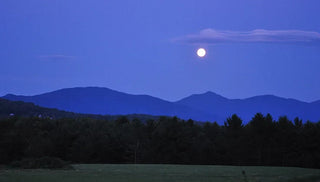Several years ago, when my North Carolina neighbor told me he always sowed his corn and bean seeds on an "arm" day, I had no idea what he was talking about. I'd been gardening (and writing about gardening) for more than 15 years, but I'd never heard of planting by arms, knees and other body parts. Frankly, it was a little unnerving at first, listening to this elderly gentleman elaborate on his gardening anatomy lesson. He never mentioned anything about the moon, so it took me a while to connect his planting practices with the more well-known practice of sowing seed according to the lunar cycles.
I dug around a bit and learned that, during its month-long orbit around the earth, the moon travels through each of the twelve zodiac signs, staying in each sign for two to three days at a time. And although I was aware that each zodiac sign is associated with earth, air, fire or water, it was news to me that each sign was also linked with one or more body parts. Gemini, for example, is an air sign and is associated with arms and chest. Capricorn is an earth sign, associated with knees. Some water and earth signs are deemed fruitful; when the moon is in that constellation, "moon gardeners" consider that a good time to sow. Air and fire signs are deemed barren — a time to forego planting and focus on weeding and pruning.
My neighbor Plummer (yep, that was his first name) was 86 years old and still planted a huge garden each spring. The first year I moved next door to his western North Carolina garden plot, I gave him a hand with planting and weeding, and he, in turn, gave me as many vegetables as I wanted, along with occasional nuggets of gardening wisdom.
I used to tease him about his anatomical planting schedule. After all, I'm more of a plant-it-when-I-have-time gardener, which usually means weekends. What if "arm day" falls on a Tuesday? Are my beans doomed? Plummer didn't mind the teasing as long as I helped him sow his half-runner beans and continued to bring him his afternoon glass of iced sweet tea. Secretly, though, I wondered if his garden's success could be attributed in any way to the planting calendar he followed.
I've grown enough corn and beans to know that it's possible to plant the seeds any time the weather has settled and the soil has warmed and dried out enough to prevent rot. So is gardening by the moon a silly anachronism, or is there a scientific basis for the practice?
Proponents suggest that, just as the moon's gravitational pull affects the tides, it also has a more subtle but still relevant effect on soil moisture, pulling it toward the soil surface. If this is true, then perhaps more moisture near the soil surface could improve germination. In addition, some seeds, such as lettuce, germinate better when they're exposed to light, so planting during the full moon could, in theory, enhance germination. (Many common weed seeds also germinate better when exposed to light, so the full moon could be a good indication that it's time to bring out the hoe and take care of the tiny weed seedlings.)
 Proponents believe that root crops are best planted during the waning moon (going from full moon to new moon).
Proponents believe that root crops are best planted during the waning moon (going from full moon to new moon).To complicate things further, certain phases of the moon are considered more conducive to planting. For example, moon-based planting calendars suggest sowing seeds for crops that yield an aboveground harvest when the moon is increasing (going from new moon to full moon). Root crops, on the other hand, are best planted during the waning moon (going from full moon to new moon).
I've never tested these theories in my own garden and couldn't find research that yielded proof that gardening by the moon really produces bigger, better yields. Still, I'm fascinated by the lore and long history of moon gardening, and I loved listening to Plummer's stories of his childhood in the rural hill country of western North Carolina.
When Plummer was a child, long before the highways were constructed, the mountainous topography and rough roads kept communities isolated and traditions alive through the generations. He grew up at a time when homesteading wasn't a trend or quaint notion, it was a means of survival. Plummer recalled how he and his friends all brought their shotguns to school with them, lining up the guns along the wall near their coats. On the way out the door at the end of school day they'd grab their coats and guns, and these grade-school boys were expected to shoot something for dinner - squirrel, rabbit, woodchuck - anything to put meat on the table. (How the world has changed!) Families grew every vegetable they ate, and canned enough extra to get them through the long mountain winters. Their survival depended on the harvest, and parents passed their gardening knowledge to their children.
So, does planting by the moon really work? Maybe some day I'll conduct my own experiments, sowing some seeds according to the lunar calendar and comparing them to seeds sown at the "wrong" time. Until then, I'll fondly remember Plummer and his long legacy of "moon gardeners" as I sow my seeds each spring.




